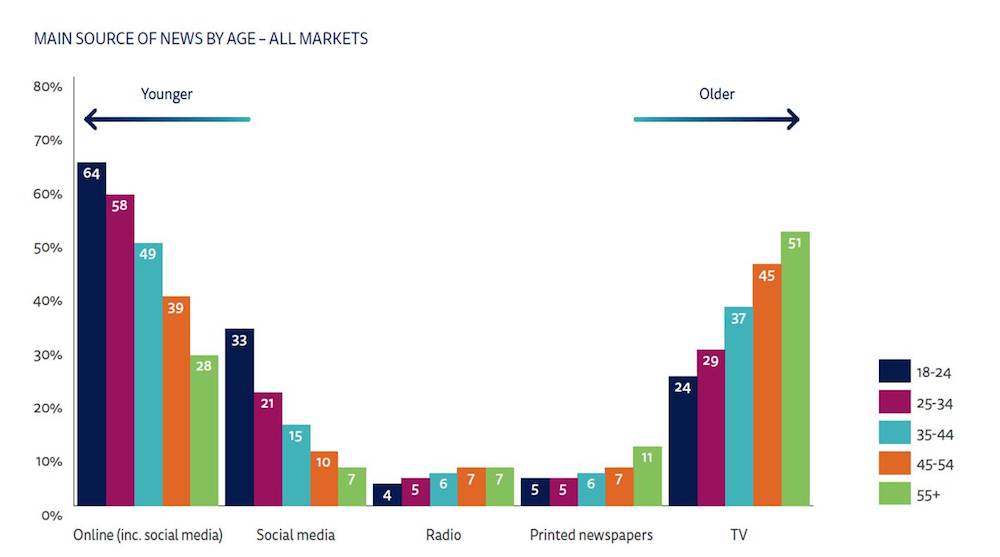News Consumption by Age Tells Only Part of a Still Evolving Story
The infographic (pictured) from the Reuters Institute for the Study of Journalism is intuitive and simplistic. You can easily see that older people prefer TV news, while young audiences go for online and social media. No surprise there.
But it's misleading!
True, the "Reuters Institute Digital News Report 2017" (unveiled this week) confirms that the screens-of-preference for younger audiences are mobile and dynamic. But identifying the platform does not necessarily tell you the source of the news. Consumers may look at an online or social media site to find reporting from established journalism sources (e.g., CNN, The New York Times, Fox News Channel) or just as easily from ersatz self-proclaimed bloggers or alt-news sources. The 136-page report delves more deeply into the distinction between the reception platforms and the actual content of the news.
The Reuters Institute, which conducted the global research (30 countries on five continents) with the University of Oxford, acknowledges that the findings are "a reminder that the digital revolution is full of contradictions and exceptions."
The results are also a roadmap (however ephemeral) toward future news consumption patterns, quantifying current usage patterns and offering eye-opening ideas for media providers about where to focus for future news packaging. The findings raise questions, such as whether today's 18-to-24 year-olds (only 24% of whom now consider TV as a primary news source) will migrate to TV sets by the time they are 55+ years old. (Doubtful.)
And the study's structure forces us to consider whether "online" and "social media" platforms are truly distinct from one another. An argument can be made pro or con about their congruence. Again the big blur quickly arises, given the propensity of established media companies to put their scoops on their Twitter, Facebook and Instagram accounts — often before they go on the air.
Dozens of other fascinating factoids emerge from Reuters' study. For example, despite the popularity of social media, only 24% of respondents think it does "a good job in separating fact from fiction." Actually that's not too far different from the 40% who question whether traditional news media performs that task very well.
Nonetheless, 51% of U.S. respondents said that they now get news via social media, up 4% from last year and twice as many as in 2013, according to the study. (If you click the above link into the full report, the U.S. data starts on page 102.)

Avoiding News
Among the most threatening findings in the Reuters analysis was that 29% of people say they sometimes or often avoid news altogether because it can have a negative effect on their moods. Those are serious concerns not only for building an informed electorate but for the news networks that have enjoyed, as Reuters calls it, "a very substantial Trump bump" during the past year -- a boomlet that could quickly evaporate.
Of similar concern for traditional platforms is the finding that smartphones are now as important for news access inside the home as outside, suggesting that media consumers don't need to turn on a TV set. The study even caught a glimmer of the role of voice-activated digital assistants (such as Amazon Echo) as a new platform for access to on-demand news. Again, this suggests that legacy news sources must explore ways to become apparent via this emerging platform.
One encouraging aspect of the Reuters' study is that more Americans "than ever before (16%)" are willing to pay for online news, a 7% increase from last year. It also cited last year's Pew Center study that technology platforms now "command nearly two-third of all digital advertising revenues." In its roster of top U.S. news brands, local TV stations, Fox News, CNN and NBC/MSNBC took most of the top spots, with more than 25% of viewers indicating that they go to those channels every week. Online, CNN (22%) and Fox News (20%) attracted more weekly visitors than The New York Times, local TV news online and the websites of local newspapers.
In its evaluation of brand attributes, Reuters found that 49% of Fox News viewers say it is best for "accurate and reliable news" compared with 32% who say the same of CNN. Similar comparisons of FNC and CNN viewers generated similar preferences among each network's audiences for "understanding complex issues," "strong viewpoints" and "amusing and entertaining."
Although the Reuters analysis is merely another snapshot of the flux in the digital news era, its findings offer significant direction for networks and information purveyors about what audiences expect.
Multichannel Newsletter
The smarter way to stay on top of the multichannel video marketplace. Sign up below.
Contributor Gary Arlen is known for his insights into the convergence of media, telecom, content and technology. Gary was founder/editor/publisher of Interactivity Report, TeleServices Report and other influential newsletters; he was the longtime “curmudgeon” columnist for Multichannel News as well as a regular contributor to AdMap, Washington Technology and Telecommunications Reports. He writes regularly about trends and media/marketing for the Consumer Technology Association's i3 magazine plus several blogs. Gary has taught media-focused courses on the adjunct faculties at George Mason University and American University and has guest-lectured at MIT, Harvard, UCLA, University of Southern California and Northwestern University and at countless media, marketing and technology industry events. As President of Arlen Communications LLC, he has provided analyses about the development of applications and services for entertainment, marketing and e-commerce.

